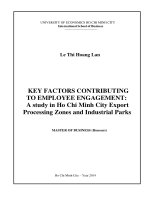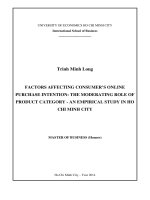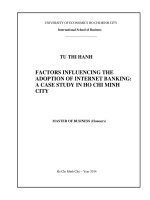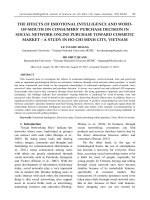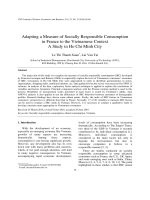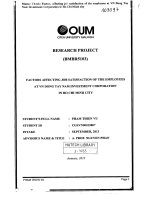Factors affecting consumers online puchase intention the moderrating role of product category an empirical study in ho chi minh city
Bạn đang xem bản rút gọn của tài liệu. Xem và tải ngay bản đầy đủ của tài liệu tại đây (1.87 MB, 119 trang )
UNIVERSITY OF ECONOMICS HO CHI MINH CITY
International School of Business
------------------------------
Trinh Minh Long
FACTORS AFFECTING CONSUMER’S ONLINE
PURCHASE INTENTION: THE MODERATING ROLE OF
PRODUCT CATEGORY - AN EMPIRICAL STUDY IN HO
CHI MINH CITY
MASTER OF BUSINESS (Honors)
Ho Chi Minh City – Year 2014
UNIVERSITY OF ECONOMICS HO CHI MINH CITY
International School of Business
------------------------------
Trinh Minh Long
FACTORS AFFECTING CONSUMER’S ONLINE
PURCHASE INTENTION: THE MODERATING ROLE OF
PRODUCT CATEGORY - AN EMPIRICAL STUDY IN HO
CHI MINH CITY
ID: 22120054
MASTER OF BUSINESS (Honors)
SUPERVISOR: DR. NGUYEN QUYNH MAI
Ho Chi Minh City – Year 2014
Running head: FACTORS AFFECTING CONSUMER’S ONLINE PURCHASE INTENTION: THE
MODERATING ROLE OF PRODUCT CATEGORY - AN EMPIRICAL STUDY IN HCMC
Factors Affecting Consumer’s Online Purchase Intention: The Moderating Role of
Product Category - An Empirical Study in Ho Chi Minh City
Trinh Minh Long
0938727169
Dr. Nguyen Quynh Mai
MBUS 3
Dec, 08th, 2014
ii
ACKNOWLEDGEMENTS
I would like to express my deepest gratitude to my advisor, Dr. Mai Nguyen, for her
excellent guidance, caring, patience, and providing me with a great atmosphere for doing
research. Her guidance helped me in all the time of research and writing of this thesis. I
could not have imagined having a better advisor and mentor for my Master thesis.
Besides my advisor, I would like to thank my friends, and other workers in the
Engineering Service Department, Software Center of Excellence Department at LogiGear
Corporation in Ho Chi Minh City for helping me to collect mussel samples from the field.
My research would not have been possible without their helps.
My sincere thanks go to my mom, two elder brothers, and younger sister. They were
always supporting me and encouraging me with their best wishes.
Last but not the least, I would like to thank my girlfriend, Dao Ninh. She was always
there cheering me up and stood by me through the good times and bad.
iii
Table of Contents
Chapter 1:
Introduction ......................................................................................................1
1.1. Background of the Study ..........................................................................................1
1.2. Problem Statement ....................................................................................................4
1.3. Research Objective ...................................................................................................7
1.4. Research Question.....................................................................................................7
1.5. Research contributions ..............................................................................................8
1.5.1.
Theoretical contributions .............................................................................8
1.5.2.
Practical contributions .................................................................................8
1.6. Scope of the study .....................................................................................................9
1.7. Organization of the Study .......................................................................................11
Chapter 2:
Literature Review ...........................................................................................12
2.1. Introduction .............................................................................................................12
2.2. Behavioral Intention Models...................................................................................12
2.2.1.
Theory of Reasoned Action (TRA) ...........................................................12
2.2.2.
Theory of Planned Behavior (TPB) ...........................................................14
2.2.3.
Technology Acceptance Model (TAM).....................................................15
2.3. Overview of the Preliminary Model .......................................................................16
2.4. Conceptual Framework and Proposed Hypotheses ................................................18
2.4.1.
Perceived usefulness (PU) .........................................................................19
2.4.2.
Perceived ease of use (PEOU) ...................................................................19
2.4.3.
Perceived risk (PR) ....................................................................................20
2.4.4.
Brand orientation (BO) ..............................................................................21
iv
2.4.5.
Prior online purchase experience (POPE) .................................................22
2.4.6.
Product category ........................................................................................23
2.5. Chapter summary ....................................................................................................26
Chapter 3:
Research Method ............................................................................................27
3.1. Introduction .............................................................................................................27
3.2. Research design.......................................................................................................27
3.3. Measurement and Questionnaire Design ................................................................27
3.3.1.
Measurement ..............................................................................................27
3.3.2.
Questionnaire design .................................................................................29
3.4. Data Collection Method ..........................................................................................30
3.5. Data Analysis Method .............................................................................................31
3.5.1.
Descriptive statistics ..................................................................................31
3.5.2.
Exploratory factor analysis (EFA) .............................................................31
Correlation matrix analysis ............................................................................32
Kaiser-Meyer-Olkin (KMO) Measure of Sampling Adequacy/Bartlett's Test
of Sphericity ...................................................................................................32
Factor extraction analysis ...............................................................................32
Rotation analysis ............................................................................................33
3.5.3.
Reliability analysis .....................................................................................33
3.5.4.
Correlation Analysis ..................................................................................33
3.5.5.
Multiple Regression ...................................................................................33
(1) Normality ..................................................................................................34
(2) Linearity....................................................................................................34
(3) Independence of error term ......................................................................34
v
(4) Absence of multicollinearity ....................................................................34
(5) Absence of heteroscedasticity ..................................................................34
(6) Absence of outlier and influential observations .......................................34
3.6. Chapter summary ....................................................................................................35
Chapter 4:
Research Results ............................................................................................36
4.1. Introduction .............................................................................................................36
4.2. Profile of Respondents ............................................................................................36
4.3. Descriptive statistics ...............................................................................................38
Perceived usefulness (PU) ..............................................................................39
Perceived ease of use (PEOU) .......................................................................39
Perceived risk (PR).........................................................................................40
Brand orientation (BO)...................................................................................40
Prior online purchase experience (POPE) ......................................................41
Online purchase intention (OPI) ....................................................................41
4.4. Factor analysis.........................................................................................................42
4.5. Reliability Test ........................................................................................................45
4.6. Correlation Analysis ...............................................................................................47
4.7. Multiple Regression ................................................................................................47
4.7.1.
Assumption for Multiple Regression .........................................................47
4.7.2.
Hypotheses Test .........................................................................................48
4.7.3.
The Moderating Effect ...............................................................................51
4.7.4.
Summary of Model Analysis .....................................................................54
4.8. Chapter summary ....................................................................................................56
Chapter 5:
Discussion and Conclusion ............................................................................57
vi
5.1. Introduction .............................................................................................................57
5.2. Discussion ...............................................................................................................57
5.2.1.
Relationship between perceived usefulness and consumer’s online
purchase intention ..........................................................................................58
5.2.2.
Relationship between perceived ease of use and consumer’s online
purchase intention ..........................................................................................59
5.2.3.
Relationship between perceived risk and consumer’s online purchase
intention ..........................................................................................................60
5.2.4.
Relationship between brand orientation and consumer’s online purchase
intention ..........................................................................................................62
5.2.5.
Relationship between prior online purchase experience and consumer’s
online purchase intention ...............................................................................63
5.2.6.
The moderating effect of product category ...............................................64
5.3. Implications .............................................................................................................65
5.3.1.
Theoretical .................................................................................................65
5.3.2.
Practical .....................................................................................................66
5.4. Limitations ..............................................................................................................68
5.5. Recommendations ...................................................................................................69
5.6. Conclusion ..............................................................................................................70
References ..............................................................................................................................72
APPENDIX A1 ........................................................................................................................ i
APPENDIX A2 ........................................................................................................................v
APPENDIX B......................................................................................................................... ix
APPENDIX C...........................................................................................................................x
APPENDIX D ........................................................................................................................ xi
vii
APPENDIX E ....................................................................................................................... xiii
APPENDIX F .........................................................................................................................xv
APPENDIX G .................................................................................................................... xviii
APPENDIX H ...................................................................................................................... xxi
viii
List of tables
Table 3.1: Measurements and Sources ...................................................................................28
Table 4.1: Respondents’ Demographic Profile ......................................................................37
Table 4.2: Online purchasing characteristics .........................................................................38
Table 4.3: Means and standard deviations of items measuring perceived usefulness ...........39
Table 4.4: Means and standard deviations of items measuring perceived ease of use ..........40
Table 4.5: Means and standard deviations of items measuring perceived risk ......................40
Table 4.6: Means and standard deviations of items measuring brand orientation .................41
Table 4.7: Means and standard deviations of items measuring prior online purchase
experience ...............................................................................................................................41
Table 4.8: Means and standard deviations of items measuring online purchase intention ....42
Table 4.9: KMO and Bartlett's Test .......................................................................................43
Table 4.10: Rotated Component Matrix a ..............................................................................44
Table 4.11: Total Variance Explained....................................................................................45
Table 4.12: Reliability Statistics ............................................................................................46
Table 4.13: Pearson Correlation Coefficient ..........................................................................47
Table 4.14: Model Summary ..................................................................................................49
Table 4.15: ANOVAa .............................................................................................................49
Table 4.16: Result of Multiple Regression Analysisa ............................................................50
Table 4.17: Correlation between Moderator, Dependent and Independent Variables ...........52
Table 4.18: Model Summaryc with Moderator .......................................................................52
Table 4.19: Result of Regression Analysisa with Moderator .................................................53
Table 4.20: Product category differences in online shopping (books: n=89; electronics: n =
106; clothing: n=124) .............................................................................................................54
Table 5.1: Summary of Hypotheses Results ..........................................................................58
ix
List of figures
Figure 1.1: Trends of revenue from electronic means .............................................................2
Figure 1.2: Purposes of accessing Internet ...............................................................................3
Figure 1.3: Popular online products on e-commerce website purchased ...............................10
Figure 1.4: The types of products or services introducing on e-commerce websites ............10
Figure 2.1: Theory of reasoned action model ........................................................................13
Figure 2.2: Theory of planned behavior .................................................................................14
Figure 2.3: Technology acceptance model .............................................................................15
Figure 2.4: Conceptual Model ................................................................................................26
Figure 4.1: Final Research Model ..........................................................................................55
x
Lists of abbreviations
ANOVA
Analysis of Variance
B2B
Business to Business
B2C
Business to Consumer
BI
Behavioral intention
BO
Brand Orientation
C2C
Consumer to Consumer
DVD
Digital Versatile Disc (formerly Digital Video Disc)
EFA
Exploratory Factor Analysis
IS
Information System
ISB
International School of Business
IT
Information Technology
HCMC
Ho Chi Minh City
HMRA
Hierarchical Moderator Regression Analysis
OPI
Online Purchase Intention
PEOU
Perceived Ease of Use
POPE
Prior Online Purchase Experience
PR
Perceived Risk
PU
Perceived Usefulness
TAM
Technology Acceptance Model
TPB
Theory of Planned Behavior
TRA
Theory of Reasoned Action
UK
United Kingdom
U.S.
United States
USD
United States Dollar
VECITA
Vietnam E-Commerce and Information Technology Agency
xi
Abstract
E-commerce is recognized for its ability to allow business to communicate and to form
transaction anytime and anyplace. Lazada, 5giay are good examples of e-commerce
business individuals and businesses are able to post their items and sell them around the
nationwide. Despite the potential in Vietnamese consumers, there is still lack of
understanding towards online shopping in Vietnam. So, this study explores factors that
affect consumers’ intention to purchase online and the moderating role of product category
by reviewing prior literatures. Based on the Technology Acceptance Model (Davis, 1989)
extended, six hypotheses were developed in the study using five independent variables of
perceived ease of use, perceived usefulness, perceived risk, prior online purchase
experience, and brand orientation and the moderator of product category. The data was
collected using web-based and fill in on-the-spot questionnaire surveys of Internet users
aged between 16 and 45 including both online visitors (non-shoppers) and purchasers
(shoppers) with a response rate of 77 percent at sample size of 319. Multiple regression
analysis is employed in this study to analyze the data and test the developed hypotheses by
using SPSS. The findings showed that all of five factors have a significant impact on
consumers’ online purchase intention. Accordingly, perceived usefulness is found as the
most important determinant, followed by prior online purchase experience. In addition, the
study confirmed the product type differences in consumers’ online shopping experience,
perceptions risks and usefulness, brand orientation associated with online shopping. This
research will be not only benefit to e-retailers’ marketers who wish to propose the good
marketing strategies in relation to increasingly market of its product, but will be useful to
web developers as an input in their design process for websites’ interface, search product
engine and payment transactions in various product type. In addition, the findings may help
the Vietnamese government a view to facilitate and support this new emerging technology
to catch up with world trends, which will ultimately be beneficial to the country as a whole.
Keywords: online purchase intention, perceived usefulness, perceived ease of use,
perceived risk, brand orientation, prior online purchase experience, and product category.
1
Chapter 1: Introduction
1.1. Background of the Study
The advent of the Internet, along with the development of related technologies, has
created a significant impact on the lives of people around the globe. Accordingly, online
shopping has grown tremendously all over the world. This has opened a window and
business opportunity for all businesses because of its ability to make viable the conduct of
business in cyberspace, or by connecting people worldwide without geographical limitations
(Singh, Jayashankar, & Singh, 2001). Meanwhile, consumers can purchase goods and
services virtually anywhere, 24 hours a day, 7 days a week without worrying about store
hours, time zones, or traffic jams (Li & Gery, 2000).
The use of the Internet as a shopping or purchasing medium has been growing with an
impressive pace in the past decade. According to ACNielsen (2008), 875 million of the
world population had made an online purchase in 2008 compare to 627 million in 2006.
Among internet users, the highest percentage shopping online is found in South Korea,
where 99 percent of those with internet access have used it to shop, followed by the United
Kingdom (97%), Germany (97%), Japan (97%) with the United States eight, at 94 percent.
A study by Indvik (2013) reported that e-commerce market would grow from $857 billion
in 2011 to $1,860 billion in 2016 and the online retail sales in US amounted to $308 billion
in 2011, and this would likely reach $546 billion in 2016.
Online shopping in Vietnam is still a new technology breakthrough since it has just
begun to assault the Vietnamese retailing sector with online shopping services. The Vietnam
E-commerce Report 2013 published by Vietnam E-Commerce and Information Technology
Agency (VECITA) showed that in term of the business sectors, the rate of enterprises in
wholesale, retail sector joining e-marketplaces stayed in the moderate rate of 15%
(VECITA, 2014). The finance, estate and industry sectors were in the highest rate to
participate in e-marketplace with 28% and 20% respectively. 85% of surveyed enterprises
answered the efficiencies of participating e-marketplaces were moderate or good levels,
2
15% respondents evaluated these efficiencies in low levels. According to 2013 VECITA’s
survey results, 41% of businesses said their revenue increased throughout e-commerce
channel, 13% decreased and 46% almost unchanged. Particularly, the effectiveness of ecommerce review is relatively stable in the past few years (VECITA, 2014).
Source: Survey of Vecita in 2013
Figure 1.1: Trends of revenue from electronic means
As reported by Vietnam E-commerce and Information Technology Agency, in 2013,
the numbers of internet users in Vietnam, accounted for 36% of the population and 57% of
them have done online transactions. In particular, the e-commerce sales per online buyer are
approximately $120 and the most popular items purchased on the internet are clothes, shoes
and cosmetics, followed by technology, air ticket, food and book (Quantrimang, 2013). The
e-commerce market in Vietnam amounted to $2.2 billion in 2013. Forecasting by 2015,
Vietnam will have 40-45% of Internet users. Goes along with the increase of Internet user in
2015 as well as the economic growth rate, the e-commerce legal framework will be
completed; the development trend of logistic infrastructure and payments will increasingly
be concerned. Pursuant to the findings, the rate of Internet users purchasing items online is
predicted to increase by 2015. Based on the above-mentioned figures and an estimated
increase of 30 USD in each online consumer’s spending in 2015 in comparison with 2013,
Vietnam B2C e-commerce sales will reach around 4 billion USD (VECITA, 2014). In
3
comparison with the major powers in the world of e-commerce as the U.S. ($343 billion),
Japan ($127 billion), UK ($124 billion) and China ($110 billion), the e-commerce market is
still quite small (PwC, 2013).
Appropriately, although sales of products from the Internet account for only a small
percentage of total retail sales, millions of consumers shop and buy on the Internet.
Therefore, many companies in Vietnam are also rushing to establish an Internet presence
despite a great deal of confusion about the actual impact of this new medium on their
businesses. To increase online shopping in Vietnam, the understanding of consumer’s
online shopping behavior and the factors that influence this behavior when shopping online
should be given priority. Researches indicate that majority of Vietnamese especially young
people were using internet for non-shopping activities such as seeking for information
(87%), using social network or forum (73%) or accessing e-mail (71%); and only 20% for
shopping online (VECITA, 2014).
Source: Survey of E-commerce and Information Technology Agency 2013
Figure 1.2: Purposes of accessing Internet
Depending on Levin, Levin, and Weller (2005), consumers tend to rely on different
information sources to confirm product quality and enhance the likelihood of satisfaction
when purchasing different types of products. They differ in their preferences for online and
4
traditional outlets based on the varied importance associated with different product
attributes (Levin, Levin, & Weller, 2005). Thus, researchers propose that online products
can be categorized by whether their dominant product attributes are digital or non-digital
(Biswas & Biswas, 2004; Lal & Sarvary, 1999). Digital products, defined as “all product
attributes can be communicated through the Internet” (Lal & Sarvary, 1999, p. 487), have
less inherent product risk in the online channel than non-digital products that may require
physical inspection of the product (Lal & Sarvary, 1999). Levin et al. (2005) find that
consumers place greater value on the ability to touch and inspect apparel products and thus
prefer traditional stores for apparel shopping. In contrast, consumers place greater value on
immediate access to product related information when purchasing product such as books
and therefore, prefer shopping online for digital products.
In order to understand the factors that affects consumer’s online purchase intention, a
lots of studies have been conducted using traditional behavioral intention models and
theories, such as Theory of Reasoned Action (TRA) (Fishbein & Ajzen, 1975), Technology
Acceptance Model (TAM) (Davis, 1989) and Theory of Planned Behavior (TPB) (Ajzen,
1991). In this research, TAM is used as the foundation of the research. It is believed to be
the most appropriate model, which can explain Information Technology (IT) or Information
System (IS) behavioral intention well and operate in valid and reliable instruments
(Mathieson, 1991).
1.2. Problem Statement
The role of a shopper’s personal attitudes has been widely acknowledged in the
consumer decision-making and behavioral intentions. In particular, service attitude is a
bridge between consumer characteristics and consumer satisfy their needs (Ajzen, 1991).
Furthermore, the behavior of consumers’ online shopping have also been influenced by their
characteristics, such as personality, demographics and perception of the online shopping
benefits (Goldsmith & Flynn, 2004). Therefore, identifying the relative importance of each
choice’s determinant for a certain action can be a useful step in understanding why such
5
behavior happens. Meanwhile, behavioral intention is determined by an individual 's attitude
towards the implementation of the act. Awareness of an individual on the behavior’s
benefits, as well as the individual's self-efficacy and the ability to control both internal and
external resources on the behavior in implementing the intended behavior, leading to the
development of the Theory of Reasoned Action (TRA), Theory of Planned Behaviour
(TPB) and Technology Acceptance Model (TAM). Based on the perspective of e-business,
knowledge of TRA, TPB, and TAM could provide a reasonable basis for explaining and
predicting consumers' intention towards adopting online shopping behavior (Choi &
Geistfeld, 2004). Choi and Geistfeld (2004) argue that online shopping is perceived to be
more risky than brick-or-mortar retailing transaction. Additionally, since consumer behavior
is cultural-specific, it is unclear whether the results reported by consumers intend to
purchase online in Western countries can be directly applied in an Eastern country as in
Vietnam.
Dann and Dann (2001) argue that the rise of online shopping phenomenon of
consumers is due to the easy accessibility to information online, so consumers are becoming
more knowledgeable and efficient by shopping online. Although a lots of studies have
concentrated on online shopping in the world, there is still a necessity for a closer
examination of the consumers’ online shopping intention in specific countries (Salisbury,
Pearson, Pearson, & Miller, 2001). Internet in Vietnam is still considered as a new medium
between retailers and consumers, and retaining consumers on e-retail is the most
problematic for any e-retail store (Dai, Forsythe, & Kwon, 2014). To increase understanding
in this area, the questions need an accurate answer.
In 2013, Vietnam had a big progress of the online transaction types in both business
to business (B2B) and business to consumer (B2C) (Ha, 2014). Considering the general
aspects of the market, the selection of business models for e-commerce plays a very
important role in increasing the awareness level of customers as well as the revenue. In the
end 2010, the advent of groupon web pages as muachung.vn, hotdeal.vn, nhommua.vn has
changed completely electronic commercial in Vietnam. The economic benefits are brought
6
in by these sites have encouraged customers to participate in the e-commerce strongly and
created a very large spillovers (Ha, 2014). Currently, e-commerce in Vietnam is still highly
fragmented in both consumer to consumer (C2C) and business to consumer (B2C) segments
(Ha, 2014). The notable sites work on this model include in vatgia.com, enbac.vn, 5giay.vn
while typical e-retailers are solo.vn, tiki.vn, yes24.vn, lazada.vn, zalora.vn, etc. Besides,
thegioididong.com and nguyenkim.com of the leading retail companies were known as most
popular online sales channels with Vietnamese consumers (Quantrimang, 2013). The
expectation of this study is to provide relevant results to the e-retail company to engage the
consumers to shop online. E-retailer can be more attractive to encourage consumers
shopping on the Internet in Vietnam.
In addition, the dependence on different sources of information (e.g., search vs.
experience) for different product categories in traditional shopping channels also exists in
the online shopping context. Past researches have established that, depending on the type of
products being purchased, shoppers tend to rely on different information sources to make
purchasing decisions in traditional shopping environment (e.g. brick-and-mortar stores)
(Nelson, 1970). However, many extant researches on online shopping have ignored the
effect of different product category on shoppers’ intention in Vietnam (Dai et al., 2014).
More importantly, eligible product categorization scheme (e.g., search vs. experience) in
traditional retail setting may not readily apply to the online setting. Although some products
(e.g., apparel) have inherent risks when purchasing online, published researches have failed
to, with the exception of Biswas and Biswas (2004), provide a compelling evidence for
recognition knowledge of how online shoppers’ risk perceptions vary by product category
or how specific risk perceptions influence online purchase intentions for various product
types.
Despite the potential in Vietnamese consumers, there is still lack of understanding
towards online shopping in Vietnam. Online retailers will be successful only if they provide
value to the consumers; hence, Internet marketers should understand the customers’
expectations and intentions regarding Internet shopping. The research can help these online
7
retailers to understand their customers, satisfy their needs and wants, and create value for
them.
1.3. Research Objective
The purpose of this research is to identify the determinants affecting consumer’s
online purchase intention, using product category as moderating factor in Ho Chi Minh
City, Vietnam. More specifically, the research mainly seeks to achieve the following
objectives:
-
To determine factors influencing consumers’ online purchase intention in Ho Chi
Minh City.
-
To examine the moderating effect of product category on the relationship between
the factors and consumers’ online purchase intention.
1.4. Research Question
Based on the discussion above, and to accomplish the objective of this study, the
proposed questions to be answered in this research are as follow:
-
Does perceived usefulness of online shopping contribute towards consumer’s online
purchase intention?
-
Does perceived ease of use contribute towards consumer’s online purchase intention?
-
Does perceived risk contribute towards consumer’s online purchase intention?
-
Does brand orientation contribute towards consumer’s online purchase intention?
-
Does prior online purchase experience contribute towards consumer’s online
purchase intention?
-
Are there differences above impacts among various product categories?
Above factors (perceived usefulness, perceived ease of use, perceived risk, brand
orientation, and prior online purchase experience) are further discussed in the second
chapter under conceptual framework.
8
1.5. Research contributions
1.5.1. Theoretical contributions
The explanatory model has been examined through the existing literature to find a
suitable model to explain consumers' behavioral intentions in purchasing products online.
Further, we use product category as the important control variable for studying the
relationship between factors and intention to purchase online. TAM is chosen for this study
due to its consistent ability to explain a significant portion of the difference from behavioral
intentions and actual behavior deriving mainly from the research into buying products
relating to technology (Adam, Nelson, & Todd, 1992; Mathieson, 1991; Davis, Bagozzi, &
Warshaw, 1989). This model seems to be a good model capable of explaining purchase
intention of consumers when shopping online and the moderating role of kinds of products
on which there has currently a little literature. Therefore, this research contributes to the
body of knowledge in this field.
1.5.2. Practical contributions
In addition to the theoretical contributions mentioned as above, the findings of this
study also affect many applications in business management. The main practical
contributions can be summarized as follows:
-
This study provides useful information for the business management to prioritize
their resources for time, budget allocation, human resources, and investment.
-
Help marketers to better understand the customer’s intentions concerning Internet
shopping. It is hoped that the study will indicate the behavioral intentions of
consumers toward Internet shopping and also identify the variables that affect
behavioral intentions of consumers in the product category. The marketing manager
may be able to plan marketing mix to cater to the needs of online consumers and
increase consumer satisfaction by finding appropriate strategies and tactics to deal
with the underpinning factors explored in this research.
9
-
It provides useful input so that Web developers can design sites and pages of which
content and layout is more compelling and effective to attract more business from
consumers.
-
Policy makers or government can use this information to promote online business by
improving infrastructure and regulations regarding as Internet, fraud prevention,
security and privacy issues to facilitate and encourage larger participation of
consumers in buying and selling products online.
1.6. Scope of the study
Due to the nature of this research, a number of delimitation of scope had to be set for
the study as below:
-
This research is delimited to only Ho Chi Minh citizens, over 15 years of age. Ho Chi
Minh City is selected due to the highest Internet penetration rate. As stated in a
Cimigo’s report, more than 50% of the population has used the internet already in
urban Vietnam (Cimigo, 2011). The report also shows that HCMC is higher than the
average rate of 50% of the population with the rate 62% in 2011.
-
Survey is conducted in this research to gather information among people who has
browsed online shopping pages (visitors) as well as those who has experience in
online shopping (purchasers).
-
ACNielsen (2008) reported that, across the globe, the most popular items purchased
on the internet are books (41%), followed by clothing/accessories/shoes (36%),
video/DVD/games and airline ticket reservations (24%). In Vietnam, the popular
online products purchased are clothes, shoes and cosmetics accounted for 62%. The
second most popular categories were technology products (35%), followed by
household products (32%), air tickets (25%) and books, stationery (20%), and etc.
10
Source: Survey of E-commerce and Information Technology Agency 2013
Figure 1.3: Popular online products on e-commerce website purchased
Similarly, clothing and footwear, electronics, books and stationery were the top
commonly sold products on the e-commerce websites, accounted for 79% of
surveyed sites. This proportion represented a correspondence between the supply and
demand, of which 62% of people chose to purchase this kind of product online.
Based on above discussion, the study selected clothing, electronics and books as
objects of product category.
Source: Data gathered by E-commerce and Information Technology Agency 2013
Figure 1.4: The types of products or services introducing on e-commerce websites
11
1.7. Organization of the Study
This research is organized as five chapters.
Chapter 1 offers an introduction to the study, including background to the study,
statement of the problem, research objectives, research questions, the significance of the
study, and scope of the study.
Chapter 2 makes a brief reference to the theories that have been used. These
literatures summarize briefly the knowledge of recent studies, describes the conceptual
model, and hypotheses.
Chapter 3 presents research methodology, including the research design, population
and sampling plan, the instruments, procedures and methods of data analysis.
Chapter 4 presents the description and analysis of the data collected.
Finally, Chapter 5 reports in detail research findings and implications. Further, this
chapter concludes with discussion on the results derived, limitations and future research.
12
Chapter 2: Literature Review
2.1. Introduction
The purpose of this chapter is to review the relevant literature to determine the
overview of the field of inquiry, thus allowing the researcher to build a conceptual model
for testing and determining the factors that affect consumers' purchase intention to buy
online.
2.2. Behavioral Intention Models
The most popular theories which have been used to study behavioral intention in
technological products are the Theory of Reasoned Action (TRA), the Theory of Planned
Behavior (TPB), the Technology Acceptance Model (TAM) and the Diffusion of
Innovation. Most of these theories have been developed from the Theory of Reasoned
Action originally proposed by Fishbein and Ajzen (1975). The Diffusion of Innovation
Theory was focused more on the adoption of the Internet and determined the likelihood that
the innovation will be adopted rather than focusing on purchasing or shopping online. As a
result, the researcher examines only the other three frequently used theories namely, TAM,
TPB, and TRA in order to gain a better understanding on the relationships between belief,
attitude, and behavioral intention of consumers when buying products online.
2.2.1. Theory of Reasoned Action (TRA)
The theory of reasoned action (TRA), developed by Fishbein and Ajzen (1975,
1980), posits that individual behavior is driven by behavioral intentions. TRA is a model for
the prediction of behavioral intention, spanning predictions of attitude and predictions of
behavior. The subsequent separation of behavioral intention from behavior allows for
explanation of limiting factors on attitudinal influence (Ajzen, 1980). With Ajzen and
Fishbein (1980), starting from the behavioral intentions, these include the functions of an
individual’s attitude towards the behavior and the subjective norm surrounding the

